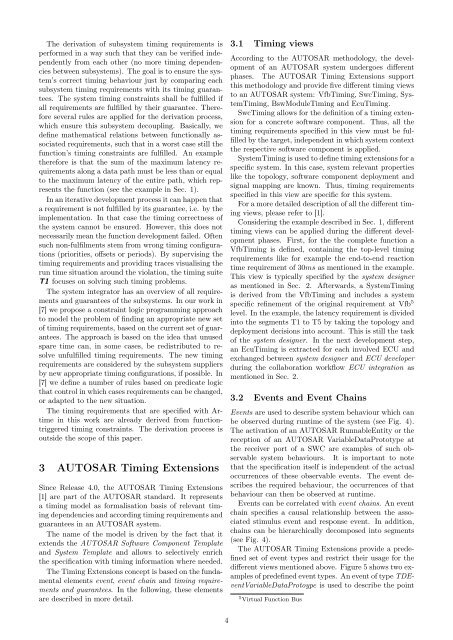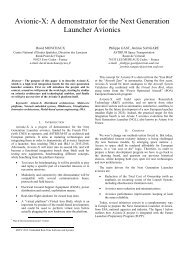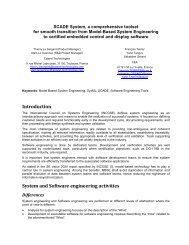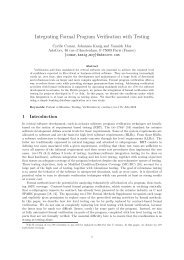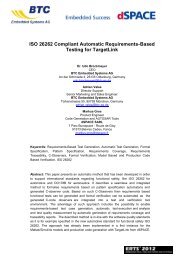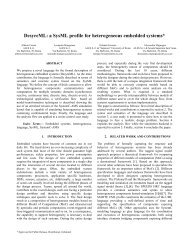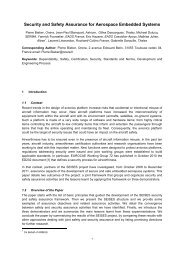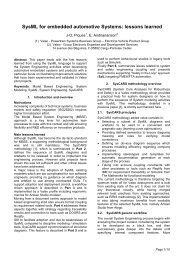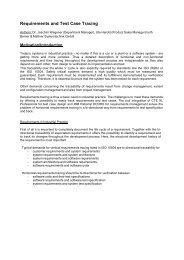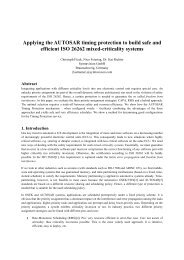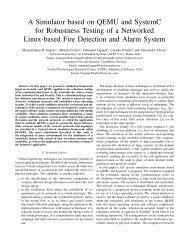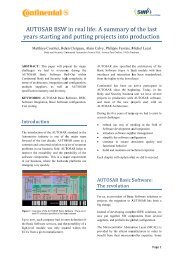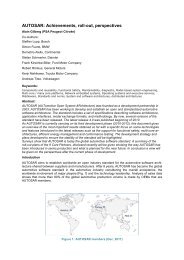Tool Support for Seamless System Development based on ...
Tool Support for Seamless System Development based on ...
Tool Support for Seamless System Development based on ...
You also want an ePaper? Increase the reach of your titles
YUMPU automatically turns print PDFs into web optimized ePapers that Google loves.
The derivati<strong>on</strong> of subsystem timing requirements is<br />
per<str<strong>on</strong>g>for</str<strong>on</strong>g>med in a way such that they can be verified independently<br />
from each other (no more timing dependencies<br />
between subsystems). The goal is to ensure the system’s<br />
correct timing behaviour just by comparing each<br />
subsystem timing requirements with its timing guarantees.<br />
The system timing c<strong>on</strong>straints shall be fulfilled if<br />
all requirements are fulfilled by their guarantee. There<str<strong>on</strong>g>for</str<strong>on</strong>g>e<br />
several rules are applied <str<strong>on</strong>g>for</str<strong>on</strong>g> the derivati<strong>on</strong> process,<br />
which ensure this subsystem decoupling. Basically, we<br />
define mathematical relati<strong>on</strong>s between functi<strong>on</strong>ally associated<br />
requirements, such that in a worst case still the<br />
functi<strong>on</strong>’s timing c<strong>on</strong>straints are fulfilled. An example<br />
there<str<strong>on</strong>g>for</str<strong>on</strong>g>e is that the sum of the maximum latency requirements<br />
al<strong>on</strong>g a data path must be less than or equal<br />
to the maximum latency of the entire path, which represents<br />
the functi<strong>on</strong> (see the example in Sec. 1).<br />
In an iterative development process it can happen that<br />
a requirement is not fulfilled by its guarantee, i.e. by the<br />
implementati<strong>on</strong>. In that case the timing correctness of<br />
the system cannot be ensured. However, this does not<br />
necessarily mean the functi<strong>on</strong> development failed. Often<br />
such n<strong>on</strong>-fulfilments stem from wr<strong>on</strong>g timing c<strong>on</strong>figurati<strong>on</strong>s<br />
(priorities, offsets or periods). By supervising the<br />
timing requirements and providing traces visualising the<br />
run time situati<strong>on</strong> around the violati<strong>on</strong>, the timing suite<br />
T1 focuses <strong>on</strong> solving such timing problems.<br />
The system integrator has an overview of all requirements<br />
and guarantees of the subsystems. In our work in<br />
[7] we propose a c<strong>on</strong>straint logic programming approach<br />
to model the problem of finding an appropriate new set<br />
of timing requirements, <str<strong>on</strong>g>based</str<strong>on</strong>g> <strong>on</strong> the current set of guarantees.<br />
The approach is <str<strong>on</strong>g>based</str<strong>on</strong>g> <strong>on</strong> the idea that unused<br />
spare time can, in some cases, be redistributed to resolve<br />
unfulfilled timing requirements. The new timing<br />
requirements are c<strong>on</strong>sidered by the subsystem suppliers<br />
by new appropriate timing c<strong>on</strong>figurati<strong>on</strong>s, if possible. In<br />
[7] we define a number of rules <str<strong>on</strong>g>based</str<strong>on</strong>g> <strong>on</strong> predicate logic<br />
that c<strong>on</strong>trol in which cases requirements can be changed,<br />
or adapted to the new situati<strong>on</strong>.<br />
The timing requirements that are specified with Artime<br />
in this work are already derived from functi<strong>on</strong>triggered<br />
timing c<strong>on</strong>straints. The derivati<strong>on</strong> process is<br />
outside the scope of this paper.<br />
3 AUTOSAR Timing Extensi<strong>on</strong>s<br />
Since Release 4.0, the AUTOSAR Timing Extensi<strong>on</strong>s<br />
[1] are part of the AUTOSAR standard. It represents<br />
a timing model as <str<strong>on</strong>g>for</str<strong>on</strong>g>malisati<strong>on</strong> basis of relevant timing<br />
dependencies and according timing requirements and<br />
guarantees in an AUTOSAR system.<br />
The name of the model is driven by the fact that it<br />
extends the AUTOSAR Software Comp<strong>on</strong>ent Template<br />
and <str<strong>on</strong>g>System</str<strong>on</strong>g> Template and allows to selectively enrich<br />
the specificati<strong>on</strong> with timing in<str<strong>on</strong>g>for</str<strong>on</strong>g>mati<strong>on</strong> where needed.<br />
The Timing Extensi<strong>on</strong>s c<strong>on</strong>cept is <str<strong>on</strong>g>based</str<strong>on</strong>g> <strong>on</strong> the fundamental<br />
elements event, event chain and timing requirements<br />
and guarantees. In the following, these elements<br />
are described in more detail.<br />
4<br />
3.1 Timing views<br />
According to the AUTOSAR methodology, the development<br />
of an AUTOSAR system undergoes different<br />
phases. The AUTOSAR Timing Extensi<strong>on</strong>s support<br />
this methodology and provide five different timing views<br />
to an AUTOSAR system: VfbTiming, SwcTiming, <str<strong>on</strong>g>System</str<strong>on</strong>g>Timing,<br />
BswModuleTiming and EcuTiming.<br />
SwcTiming allows <str<strong>on</strong>g>for</str<strong>on</strong>g> the definiti<strong>on</strong> of a timing extensi<strong>on</strong><br />
<str<strong>on</strong>g>for</str<strong>on</strong>g> a c<strong>on</strong>crete software comp<strong>on</strong>ent. Thus, all the<br />
timing requirements specified in this view must be fulfilled<br />
by the target, independent in which system c<strong>on</strong>text<br />
the respective software comp<strong>on</strong>ent is applied.<br />
<str<strong>on</strong>g>System</str<strong>on</strong>g>Timing is used to define timing extensi<strong>on</strong>s <str<strong>on</strong>g>for</str<strong>on</strong>g> a<br />
specific system. In this case, system relevant properties<br />
like the topology, software comp<strong>on</strong>ent deployment and<br />
signal mapping are known. Thus, timing requirements<br />
specified in this view are specific <str<strong>on</strong>g>for</str<strong>on</strong>g> this system.<br />
For a more detailed descripti<strong>on</strong> of all the different timing<br />
views, please refer to [1].<br />
C<strong>on</strong>sidering the example described in Sec. 1, different<br />
timing views can be applied during the different development<br />
phases. First, <str<strong>on</strong>g>for</str<strong>on</strong>g> the the complete functi<strong>on</strong> a<br />
VfbTiming is defined, c<strong>on</strong>taining the top-level timing<br />
requirements like <str<strong>on</strong>g>for</str<strong>on</strong>g> example the end-to-end reacti<strong>on</strong><br />
time requirement of 30ms as menti<strong>on</strong>ed in the example.<br />
This view is typically specified by the system designer<br />
as menti<strong>on</strong>ed in Sec. 2. Afterwards, a <str<strong>on</strong>g>System</str<strong>on</strong>g>Timing<br />
is derived from the VfbTiming and includes a system<br />
specific refinement of the original requirement at Vfb 5<br />
level. In the example, the latency requirement is divided<br />
into the segments T1 to T5 by taking the topology and<br />
deployment decisi<strong>on</strong>s into account. This is still the task<br />
of the system designer. In the next development step,<br />
an EcuTiming is extracted <str<strong>on</strong>g>for</str<strong>on</strong>g> each involved ECU and<br />
exchanged between system designer and ECU developer<br />
during the collaborati<strong>on</strong> workflow ECU integrati<strong>on</strong> as<br />
menti<strong>on</strong>ed in Sec. 2.<br />
3.2 Events and Event Chains<br />
Events are used to describe system behaviour which can<br />
be observed during runtime of the system (see Fig. 4).<br />
The activati<strong>on</strong> of an AUTOSAR RunnableEntity or the<br />
recepti<strong>on</strong> of an AUTOSAR VariableDataPrototype at<br />
the receiver port of a SWC are examples of such observable<br />
system behaviours. It is important to note<br />
that the specificati<strong>on</strong> itself is independent of the actual<br />
occurrences of these observable events. The event describes<br />
the required behaviour, the occurrences of that<br />
behaviour can then be observed at runtime.<br />
Events can be correlated with event chains. An event<br />
chain specifies a causal relati<strong>on</strong>ship between the associated<br />
stimulus event and resp<strong>on</strong>se event. In additi<strong>on</strong>,<br />
chains can be hierarchically decomposed into segments<br />
(see Fig. 4).<br />
The AUTOSAR Timing Extensi<strong>on</strong>s provide a predefined<br />
set of event types and restrict their usage <str<strong>on</strong>g>for</str<strong>on</strong>g> the<br />
different views menti<strong>on</strong>ed above. Figure 5 shows two examples<br />
of predefined event types. An event of type TDEventVariableDataProtoype<br />
is used to describe the point<br />
5 Virtual Functi<strong>on</strong> Bus


